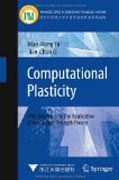
Computational plasticity: with emphasis on the application of the unified strength theory
Yu, Mao-Hong
Li, Jian-Chun
“Computational Plasticity with Emphasis on the Application of the Unified Strength Theory” explores a new and important branch of computational mechanics and is the third book in a plasticity series published by Springer. The other two are: Generalized Plasticity, Springer: Berlin, 2006; and Structural Plasticity, Springer and Zhejiang University Press: Hangzhou, 2009. This monograph describes the unified strength theory and associated flow rule, the implementation of these basic theories in computational programs, and shows how a series of results can be obtained by using them. The unified strength theory has been implemented in several special nonlinear finite-element programs and commercial Finite Element Codes by individual users and corporations. Many new and interesting findings for beams, plates, underground caves, excavations, strip foundations, circular foundations, slop, underground structures of hydraulic powerstations, pumped-storage power stations, underground mining, high-velocity penetration of concrete structures, ancient structures, and rocket components, along with relevant computational results, are presented. This book is intendedfor graduate students, researchers and engineers working in solid mechanics, engineering and materials science. The theories and methods provided in this book can also be used for other computer codes and different structures. More results can be obtained, which put the potential strength of the material to better use, thus offering material-saving and energy-saving solutions. Mao-Hong Yu is a professor at the Department of Civil Engineering at Xi'an Jiaotong University, Xi'an, China. Focusing on unified strength theory as a very broad and flexible theory for many materials. Contains new computational results that can be easily adapted for more structures. Provides method to increase admissible loads or decrease cross-sections and the weight of the structure. INDICE: Introduction. Stress and Strain. Material Models in Computational Plasticity. Unified Strength Theory and Its Material Parameters. Non-Smooth Multi-Surface Plasticity. Implementation of the Unified Strength Theory into FEMCodes. Examples of the Application of Unified Elasto-Plastic Constitutive Relations. Strip with a Circular Hole under Tension and Compression. Plastic Analysis of Footing Foundation Based on the Unified Strenghth Theory. Underground Caves, Tunnels and the Excavation of Hydraulic Power Station.-Implementation of the Unified Strength Theory into ABAQUS and its Application. 2D Simulation of Normal Penetration Using the Unified Strength Theory. 3D Simulation of Normal and Oblique Penetration and Perforation. Underground Mining. Reinforced Concrete Beam and Plate. Stability Analysis of Underground Caverns Based on the Unified Strength Theory. Stability of Slope.- Unified Strength Theory and FLAC.-Mesomechanics and Multiscale Modelling for Yield Surface. Miscellaneous Issues: Ancient Structures, Propellant of Solid Rocket, Parts of Rocket and Generator.
- ISBN: 978-3-642-24589-3
- Editorial: Springer Berlin Heidelberg
- Encuadernacion: Cartoné
- Páginas: 400
- Fecha Publicación: 29/02/2012
- Nº Volúmenes: 1
- Idioma: Inglés
